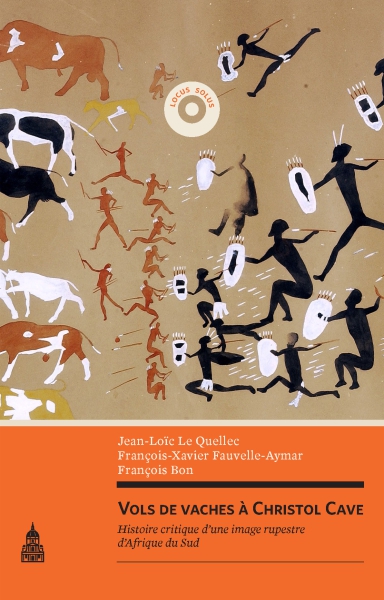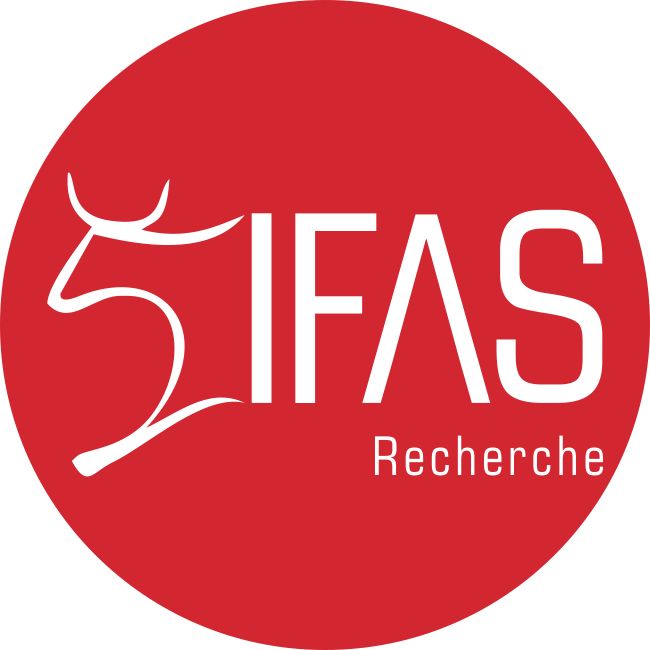Vols de vaches à Cristol Cave
Histoire critique d´une images rupestre d´Afrique du Sud
 [Cattle Theft at Cristol Cave. Critical history of a South African rock painting]
[Cattle Theft at Cristol Cave. Critical history of a South African rock painting]
Jean-Loïc le Quellec, François-Xavier Fauvell-Aymar, François Bon, 2009, Paris, Publications de la Sorbonne
ISBN-10 : 2859446338
ISBN-13 : 978-2859446338
[Book in French]
This is a rock painting, hidden in a shelter in South Africa.
On the left, we can see the attackers who are fleeing after having committed their crime. On the right, we can see the victims who, after the initial panic of the first moments, have regained their self-control and are pursuing their aggressors by brandishing spears and shields. The whole business seems straight forward: Bushmen hunter-gatherers have just swooped down on a Bantu agricultural village and stolen their cattle.
But, at the end of the 19th century, a second theft was committed, this time on the actual painting: from the shelter, French Protestant missionary Frédéric Christol, one of the first to see the painting, removed wholes pieces of rocks containing paintings of cattle so as to send them to museums in Europe, and thus testify to the presence of rock art in the confines of the known world.
Since its discovery one and a half century ago, the famous “Christol Cave” painting has been fascinating rock art experts, ethnologists and prehistorians. All saw in it a testimony that was so damning for the “Bushmen” – the last hunter-gatherers in that part of the world – that the image came to incarnate the “shock” between prehistoric hunters and farmers of the first civilisations.
And yet, is that rock painting really testifying to a “cattle theft”? Did successive commentators really see with their eyes what their reason wanted to see? We need to review the whole analysis. But is it possible to put the original document back together, despite the many instances of plundering on the painting?
By using archival documents and state-of-the-art technology, we have been able to review the painting that had almost disappeared, and see certain details that had never been seen or understood up until now…
And what if the thieves were not the ones we thought?
For the first time, a rock painting is considered as a historical document on the society that created it, but also on the societies that interpreted it.
Jean-Loïc le Quellec is a Senior Researcher with the CNRS, a Researcher at the French Institute of South Africa in Johannesburg and at the Centre d’études des mondes africains (CEMAf), and an Honorary Research Fellow at the GAES of the University of the Witwatersrand in Johannesburg. Ethnologist, anthropologist, expert in prehistory and African rock art, Saharan rock art in particular, Jean-Loïc has produced many works on Saharan and Southern African rock art. He is the chairman of the Association of the Friends of Saharan Rock Art (AARS) and co-manages the Franco-Algerian mission for the analysis and dating of rock painting from Tassili, Ahaggar and Atlas. In his many publications, Jean-Loïc uses a historical, archaeological as well as mythological approach in describing rock paintings. His latest publications include Arts rupestres et mythologies en Afrique (Flammarion, 2004, English translation: Rock Art in Africa: Mythology and Legend, 2004) and, with Pauline and Philippe de Flers, Du Sahara au Nil. Peintures et gravures d’avant les Pharaons (Soleb-Fayard, Collection d’Égyptologie du Collège de France, 2005).
François-Xavier Fauvelle-Aymar is a Senior Researcher with the CNRS (laboratoire TRACES, Toulouse) and a Honorary Research Fellow at the GAES of the University of the Witwatersrand in Johannesburg. As historian of Africa, François-Xavier has a particular interest in the forming of Southern African societies through archaeology and documentation. He published L’invention du Hottentot (Pubications de la Sorbonne, 2002), Histoire de l’Afrique du Sud (Le Seuil, 2006), and La Mémoire aux enchères. L’idéologie afrocentriste à l’assaut de l’histoire (Verdier, 2009).
François Bon is a Senior Lecturer in Prehistoric Archaeology at the University of Toulouse II – Le Mirail (Laboratoire TRACES), and an Honorary Research Fellow at the GAES of the University of the Witwatersrand in Johannesburg. François is an expert on the first societies of modern men in Western Europe. He has been conducting comparative studies in Africa for a few years now, in collaboration with François-Xavier Fauvelle-Aymar. In charge of archaeological operations in France and Ethiopia, François has authored several papers on European Upper Palaeolithic, Southern and Eastern African prehistory as well as the history of prehistory. Among his publications, L’Aurignacien entre Mer et Océan. Refléxion sur l’unité des phases anciennes de l’Aurignacien dans le sud de la France (Mémoire de la Société préhistorique française, xxix, 2002), and Préhistoire. La fabrique de l’homme (Le Seuil, 20009).
